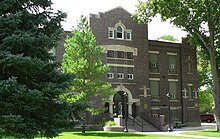Chase County, Nebraska
| Chase County, Nebraska | |
|---|---|

Chase County courthouse in Imperial
|
|
 Location in the U.S. state of Nebraska |
|
 Nebraska's location in the U.S. |
|
| Founded | 1886 |
| Named for | Champion S. Chase |
| Seat | Imperial |
| Largest city | Imperial |
| Area | |
| • Total | 897 sq mi (2,323 km2) |
| • Land | 894 sq mi (2,315 km2) |
| • Water | 3.1 sq mi (8 km2), 0.5% |
| Population | |
| • (2010) | 3,966 |
| • Density | 4.4/sq mi (2/km²) |
| Congressional district | 3rd |
| Time zone | Mountain: UTC-7/-6 |
| Website | www |
Chase County is a county in the U.S. state of Nebraska. As of the 2010 census, the population was 3,966. Its county seat is Imperial.
In the Nebraska license plate system, Chase County is represented by the prefix 72 (it had the 72nd-most vehicles registered in the state when the license plate system was established in 1922).
Chase County was named after Champion S. Chase, who served as mayor of Omaha for seven years and was Nebraska's first Attorney General.
Chase County was separated from Hayes County by the Nebraska legislature on February 27, 1873, although the county was not organized until 1886.
It was once said that, excluding ranch owners, their wives, and their cooks, at the time Chase County was organized it was populated entirely by cowboys. Part of the reason for such a statement may have been the fact that at one time Frenchman Creek and its main branch the Stinking Water Creek were used as watering stops for cattle drives that traveled from Texas to the Union Pacific railhead at Ogallala. These trails are known as the Western or Great Western trails.
Chase County sits in the region once referred to as the Great American Desert. However, on the broad, fertile plateau, early settlers quickly discovered that Chase County's dark sandy loam soil was excellent for farming.
The railroad came to Chase County in 1892, reaching Wauneta on January 28. It was built by a division of the Chicago, Burlington and Quincy Railroad. This line left the main line near Culbertson and terminated in Imperial.
Chase County is served by a three-member Board of Commissioners. County officials are directly elected. It is a part of the 44th Legislative District of the Nebraska Legislature.
...
Wikipedia
